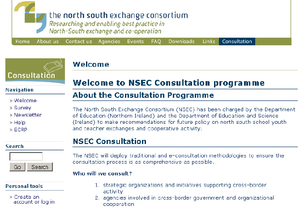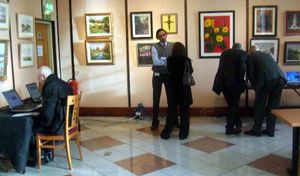NSEC E-consultation Design
This page outlines how the e-consultation was designed, with particular reference to the technologies and issues encountered.
Contents
E-Consultation Strategies
During the series of meetings that constituted the planning phase of the NSEC trial, several possible e-consultation strategies were proposed that could be used to suit NSEC's consultation needs, such as on-line surveys and the incorporation of forums into a website.
Traditional + Technological Elements Used
The considered opinion of the both NSEC and the e-consultation research team was that both conventional consultation techniques and e-consultation elements should be applied to the process.
Benefit from comparison
From NSEC's point of view it allowed all channels of communication to be exploited.
From the research team’s perspective it afforded an opportunity to:
- compare various methods
- to see how well technology fitted in with, and helped on, a public consultation.
Click here to see an overview of the econsultation planning and design process.
E-consultation for the NSEC Launch Event
NSEC planned a meeting to launch their consultation in November 2005. At the launch they would present the research reports they had commissioned on North/South Educational Exchange to an audience of educationalists from a range of stakeholders across Ireland (often at senior policy levels). Their web site, with all the research reports, would be revealed at the same time.
Launch Stages
The first stages of the e-consultation were to be launched at the same time. The first stages of the e-consultation were:
- A short e-voting session during the presentations, to get instant responses from the audience.
- The possibility to sign up to an e-newsletter, so that NSEC could e-mail people with news about educational exchange and also opportunities to participate in the consultation.
- A short on-line questionnaire. The research team designed a consultation web site for NSEC, including mailing list subscription software (PHP list), and questionnaire run on PHP Surveyor, and pages introducing the consultation and all the conventional and electronic ways in which people might participate (See thumbnail, right).
The research team also designed a set of questions for the launch meeting.
NSEC Launch Event
The NSEC launch went ahead in November 2005. Some pictures are available (right side border) of the event being set up and the presentations of the research findings.
The launch was held in the Newry Arts Centre.
Post-launch e-consultation design
Engaging the Stakeholders
People attending the launch were engaged in consultation. However, this group were not the only group that NSEC wanted to involve in their consultations, and so, NSEC considered different technologies that might help to engage other groups.
Need for Publicity and Promotion
The need for publicity and promotion was emphasised as a crucial element of the process, of which NSEC needed to do more.
Consulting those who are affected most: Organisations in Educational Exchanges
One important group to consult were the organizations that currently managed and/or funded existing educational exchanges.
The Technology
The research team suggested using group support systems. Although NSEC agreed in principle to do this, staff shortages meant they were not able to organise any group support system meetings before the research team's project ended.
Consulting those who are affected most: Young People
A second key group to consult are young people, which meant working with Northern Ireland Youth Forum (NIYF). An on-line discussion forum was used to allow many more young people to participate.
The Technology
NSEC used on-line questionnaires targeted at particular groups of participants. Also, NSEC used SugarCRM Customer Relationship Management software for keeping track of their (potentially) huge number of contacts.



